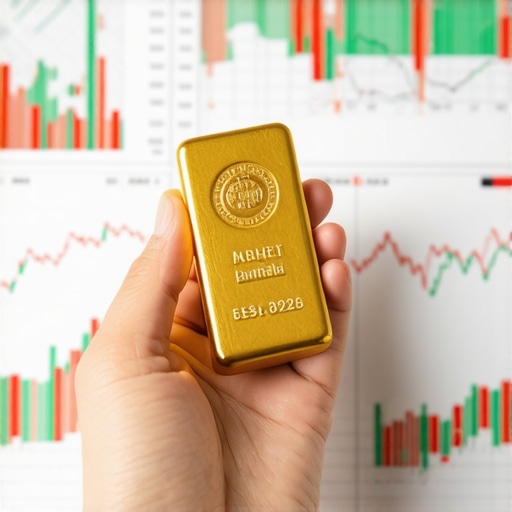Understanding Gold Futures: A Comprehensive Overview
As the investment landscape evolves, many new investors are becoming increasingly interested in gold futures, especially with the changing dynamics of the financial markets in 2025. Gold futures are contracts that allow investors to buy or sell gold at a predetermined price at a future date. This financial instrument can be an excellent way to hedge against inflation and market volatility, making it a vital component of a diversified investment portfolio.
The Appeal of Gold Futures in 2025
In 2025, the appeal of gold futures is expected to rise due to several factors. First, with ongoing economic uncertainties, gold is often seen as a safe-haven asset. Investors looking for stability might find gold futures an attractive option. Additionally, the potential for significant returns attracts traders who are willing to navigate the complexities of futures contracts.
How Gold Futures Work
Gold futures work by allowing traders to speculate on the future price of gold. When you enter into a gold futures contract, you are agreeing to buy or sell a specific amount of gold at a set price on a future date. If the market price of gold rises above the contract price, buyers can profit from the difference. Conversely, if prices fall, sellers benefit. This leverage can magnify both profits and losses, making a solid understanding of market trends essential for success.
For those new to gold futures, it’s crucial to learn about the various strategies that can be employed. Understanding the nuances of trading, such as market analysis and trend forecasting, can significantly impact your investment outcomes. For more insights into market analysis, you can explore analyzing gold market trends.
Key Considerations Before Investing in Gold Futures
Before diving into gold futures, investors should consider several key factors. Firstly, understanding the differences between physical gold and gold futures is paramount. While physical gold provides tangible ownership, gold futures offer flexibility and the possibility of leveraging investments without the need for physical storage. To better understand these differences, check out investing in gold: comparing physical gold and ETFs.
Moreover, investors should familiarize themselves with the market’s structure, including how futures exchanges operate, the role of margin requirements, and the implications of contract expiration. This knowledge will empower new investors to make informed decisions and navigate the complexities of the futures market effectively.
Staying Informed: Monitoring Gold Price Trends
Keeping an eye on gold price trends is crucial for anyone involved in trading gold futures. Factors such as geopolitical events, economic indicators, and changes in central bank policies can all influence gold prices. For instance, if inflation rates rise, gold typically becomes more attractive to investors, which can drive prices up. To stay updated, it is essential to follow reliable sources of market analysis, such as gold price trends.
As you embark on your journey into gold futures, remember that education is key. The more you understand the market, the better prepared you will be to capitalize on opportunities and mitigate risks. Whether you’re a beginner or looking to refine your strategy, resources are available to help you succeed in the world of gold futures.
Essential Strategies for Trading Gold Futures
As you delve deeper into the world of gold futures, developing effective trading strategies is crucial. Understanding the market’s behaviors and trends can significantly influence your investment success. For beginners, starting with simple strategies such as trend following or breakout trading can be beneficial. These techniques allow you to capitalize on price movements without requiring extensive experience.
Trend Following: A Beginner’s Approach
Trend following involves identifying the direction of the market—whether up or down—and making trades that align with that trend. This strategy is particularly effective in the gold market, where prices can exhibit strong directional moves based on economic data and geopolitical events. By learning to recognize these trends, you can enhance your trading performance.
To implement trend following effectively, consider utilizing tools such as moving averages or chart patterns. These tools can help you visualize price movements and make informed decisions. For those looking to refine their understanding of market patterns, resources such as gold price trends can be invaluable.
Breakout Trading: Seizing Opportunities
Breakout trading focuses on entering the market when the price surpasses established resistance or support levels. This technique can be particularly advantageous in the volatile gold market, where prices often react sharply to external factors. By anticipating these breakouts, you can position yourself to capitalize on sudden price shifts.
To effectively implement breakout trading, you should closely monitor price charts and set alerts for key levels. This proactive approach ensures that you’re ready to act when a breakout occurs, maximizing your potential gains. For additional insights into market reactions, consider exploring analyzing gold market trends.
Risk Management in Gold Futures Trading
Another critical aspect of trading gold futures is risk management. The leverage involved in futures trading can amplify both gains and losses, making it essential to implement strategies that protect your investments. A well-structured risk management plan can help you navigate the complexities of the gold market.
Setting Stop-Loss Orders
One of the most effective risk management techniques is the use of stop-loss orders. These orders automatically close your position once the price reaches a predetermined level, limiting potential losses. For instance, if you enter a long position in gold futures at $1,800 per ounce, setting a stop-loss order at $1,780 ensures that you exit the trade before losses escalate.
In addition to protecting your capital, stop-loss orders allow you to trade with more confidence. Knowing that your losses are capped can help you stick to your trading plan without emotional interference. For those looking to enhance their understanding of gold trading techniques, the article tips for beginners on gold trading techniques provides valuable insights.
Diversifying Your Portfolio
Furthermore, diversifying your portfolio can mitigate risks associated with trading gold futures. Instead of allocating all your funds to gold, consider including other asset classes, such as stocks or bonds. This strategy can reduce the impact of price fluctuations in the gold market on your overall portfolio.
By maintaining a balanced approach to investing, you can achieve more consistent returns and reduce your exposure to market volatility. For a deeper understanding of how to create a diverse investment portfolio, explore the role of gold in a diverse investment portfolio.
Keeping Up with Market Developments
Finally, staying informed about market developments is essential for successful gold futures trading. Economic indicators, central bank policies, and geopolitical events can all affect gold prices. By keeping a pulse on these factors, you can make more informed trading decisions.
Utilizing reliable news sources and market analysis platforms can help you stay ahead of trends. Engaging with communities of traders, both online and offline, can also provide you with valuable insights and perspectives. As you embark on your journey in gold futures trading, remember that continuous education and adaptability are key components of success.
Advanced Trading Techniques for Gold Futures
As you progress in your gold futures trading journey, implementing advanced techniques can significantly enhance your trading success. Understanding market psychology, employing technical analysis, and leveraging the right tools can set you apart from the competition.
Market Psychology: Understanding Trader Behavior
Market psychology plays a crucial role in gold futures trading. Recognizing how other traders react to market conditions can provide valuable insights into price movements. For instance, during periods of economic uncertainty, fear can drive investors towards gold, pushing prices higher. Conversely, when the market stabilizes, traders may shift their focus away from gold, leading to price declines. To better navigate these fluctuations, familiarize yourself with behavioral finance concepts, and consider tracking sentiment indicators.
Utilizing Technical Analysis for Informed Decisions
Technical analysis is a powerful tool for gold futures traders. By analyzing historical price data and identifying patterns, traders can make informed predictions about future price movements. Key indicators such as moving averages, Relative Strength Index (RSI), and Bollinger Bands can help you gauge market momentum and potential reversal points. To enhance your technical analysis skills, explore resources on gold price trends and how to interpret various market signals.
Leveraging Technology in Gold Futures Trading
In today’s digital age, technology plays an essential role in trading efficiency. Utilizing trading platforms equipped with advanced charting tools, algorithmic trading options, and real-time data feeds can give you a competitive edge. Many platforms also offer backtesting capabilities, allowing you to test your strategies against historical data before deploying them in live markets.
Automated Trading Systems: The Future of Trading
Automated trading systems have gained popularity among gold futures traders. These systems use algorithms to execute trades based on predefined criteria, eliminating emotional decision-making. By setting parameters such as entry and exit points, you can automate your trading strategy and capitalize on opportunities as they arise. However, it’s important to continuously monitor and adjust your system to align with changing market conditions.
Staying Ahead of Market News and Events
Being informed about market news and global events is critical for gold futures traders. Economic reports, political developments, and central bank announcements can all impact gold prices. For instance, changes in interest rates or inflation data can drive market sentiment. To stay informed, subscribe to reliable financial news sources and consider using economic calendars to track upcoming events that may affect the gold market.
Building a Robust Trading Plan
A well-structured trading plan is essential for success in gold futures trading. This plan should outline your trading goals, risk tolerance, and specific strategies. Additionally, regular reviews of your trading performance can help you identify areas for improvement and refine your approach.
Setting Realistic Goals and Expectations
Setting realistic goals is a critical component of your trading plan. Consider your risk tolerance and the time you can dedicate to trading when establishing achievable profit targets. Moreover, understand that losses are part of the trading process. Developing a mindset that embraces continuous learning and adaptation will enhance your resilience and long-term success.
Continuous Education and Skill Development
In the ever-evolving world of gold futures trading, continuous education is paramount. Stay updated on market trends, new trading strategies, and emerging technologies. Engaging with trading communities, attending webinars, and reading relevant literature can significantly enhance your knowledge and skill set. For instance, exploring effective gold price forecasting techniques can provide insights into predicting market movements.
Implementing Advanced Trading Techniques for Gold Futures Success
As traders gain experience in the gold futures market, incorporating advanced techniques can significantly enhance their trading performance. These methods not only provide deeper insights into market dynamics but also equip traders to better navigate volatile conditions.
Understanding Technical Indicators for Strategic Trading
Utilizing technical indicators is a vital aspect of advanced trading. Indicators such as Moving Averages, Fibonacci Retracement, and the Average True Range (ATR) help traders identify trends, potential reversal points, and measure market volatility. For instance, the Moving Average can smooth out price data to identify the direction of the trend, while Fibonacci levels can indicate key support and resistance levels. For a more detailed exploration of these tools, check out gold price trends.
Sentiment Analysis: Gauging Market Psychology
Understanding market sentiment is crucial for predicting future price movements. By analyzing trader behavior and market news, you can gauge whether the market is bullish or bearish. Tools like the Commitment of Traders (COT) report provide insights into how large traders are positioned in the market, which can be invaluable for making informed decisions. Engaging with platforms that analyze sentiment can enhance your trading strategy and help align it with market conditions.
Building a Comprehensive Trading Plan
A robust trading plan serves as a roadmap for your trading activities. It should encompass your trading goals, risk tolerance, and specific strategies tailored to the gold futures market.
Establishing Clear Goals and Objectives
When crafting your trading plan, set clear, measurable goals. This could include specific profit targets or the number of trades you wish to execute per week. Establishing realistic objectives not only keeps you focused but also helps maintain discipline in your trading activities. Remember, successful trading is a marathon, not a sprint.
Risk Management Strategies to Protect Your Capital
Integrating effective risk management techniques into your trading plan is essential. Consider setting a maximum loss per trade, which should be a small percentage of your total capital. This approach ensures that no single trade can significantly impact your overall portfolio. Additionally, employing stop-loss orders can help limit losses and allow for more disciplined trading. For more on risk management, refer to tips for beginners on gold trading techniques.
Regular Review and Adaptation of Your Trading Strategy
Regularly reviewing your trading plan is vital to adapting to changing market conditions. Analyze the performance of your trades, identify what worked and what didn’t, and adjust your strategies accordingly. This iterative process not only enhances your skills but also builds confidence as you become more adept at recognizing patterns and market signals.
Engaging with the Gold Trading Community
Finally, connecting with fellow traders can provide valuable insights and foster a supportive trading environment. Joining online forums, attending webinars, or participating in local trading groups can expose you to diverse perspectives and strategies. Engaging with the community can enhance your understanding and keep you motivated on your trading journey.
In conclusion, mastering gold futures trading requires a combination of advanced techniques, a solid trading plan, and a commitment to continuous learning. By integrating these elements, you can enhance your trading success and navigate the complexities of the gold market with confidence.
Frequently Asked Questions About Gold Futures Trading
What are gold futures?
Gold futures are contracts to buy or sell a specific amount of gold at a predetermined price on a set date in the future. They are primarily used by investors looking to hedge against price fluctuations or speculate on future price movements.
How do I start trading gold futures?
To start trading gold futures, you need to open an account with a brokerage that offers futures trading. After funding your account, familiarize yourself with market trends, and consider developing a trading plan that outlines your strategies and risk management techniques.
What factors influence gold futures prices?
Gold futures prices are influenced by a variety of factors, including economic indicators, inflation rates, geopolitical events, and central bank policies. Additionally, supply and demand dynamics in the gold market can also affect prices.
What is leverage in gold futures trading?
Leverage in gold futures trading allows traders to control a larger position with a smaller amount of capital. This can amplify potential gains but also increases the risk of significant losses. Understanding how to use leverage effectively is crucial for successful trading.
Are gold futures a good investment?
Gold futures can be a good investment for those looking to hedge against market volatility or inflation. However, they come with high risks due to the leverage involved and should be approached with a solid strategy and thorough market understanding.
What are the risks of trading gold futures?
The primary risks include market volatility, leverage, and the potential for sudden price movements due to external factors. Traders should implement risk management techniques, such as stop-loss orders, to help mitigate these risks.
Can I trade gold futures without physical delivery?
Yes, most traders close their futures positions before the contract’s expiration to avoid physical delivery. This is common practice in futures trading, as many traders are primarily interested in speculating on price movements.
How can I analyze gold futures market trends?
Technical analysis, fundamental analysis, and sentiment analysis are effective methods for analyzing gold futures market trends. Utilizing tools like moving averages, RSI, and market news can help you make informed trading decisions.
What resources are available for learning about gold futures trading?
There are numerous resources available, including online courses, trading forums, and market analysis websites. Books on trading strategies and market psychology also provide valuable insights into successful trading practices.
Authority Resources for Gold Futures Trading
For those looking to deepen their understanding of gold futures and stay updated on market trends, the following resources are highly recommended:
- CME Group – Gold Futures: An authoritative source on gold futures trading, providing market data and educational resources.
- Investopedia – Gold Futures Explained: A comprehensive guide on gold futures, including definitions, strategies, and market analysis.
- Kitco Metals: An industry leader in precious metals news and analysis, offering real-time gold prices and market insights.
- Bloomberg Markets: For up-to-date market news and analysis, including detailed coverage of gold and precious metals.
- World Gold Council: Provides research, news, and insights into the gold market, along with educational resources for investors.
Conclusion
Mastering gold futures trading requires a combination of knowledge, strategy, and ongoing education. By understanding market dynamics, employing effective trading techniques, and utilizing the various resources available, you can navigate the complexities of gold futures with greater confidence. Whether you are a novice or an experienced trader, staying informed and engaged with the gold market will enhance your trading success and help you achieve your investment goals.









